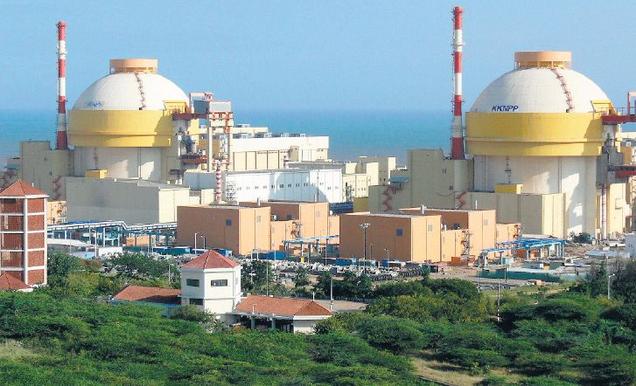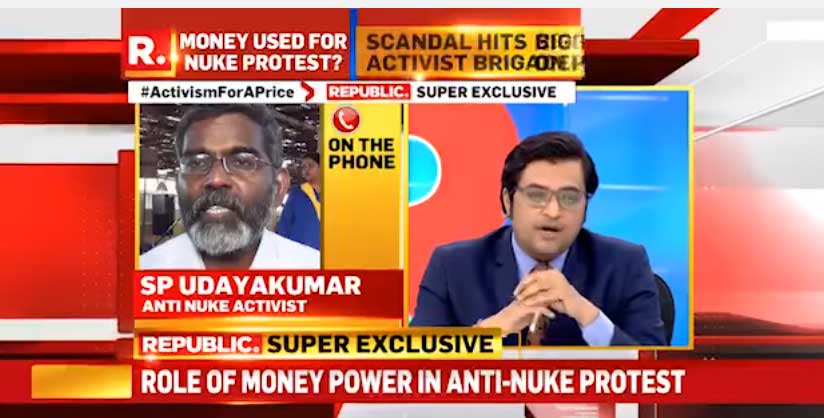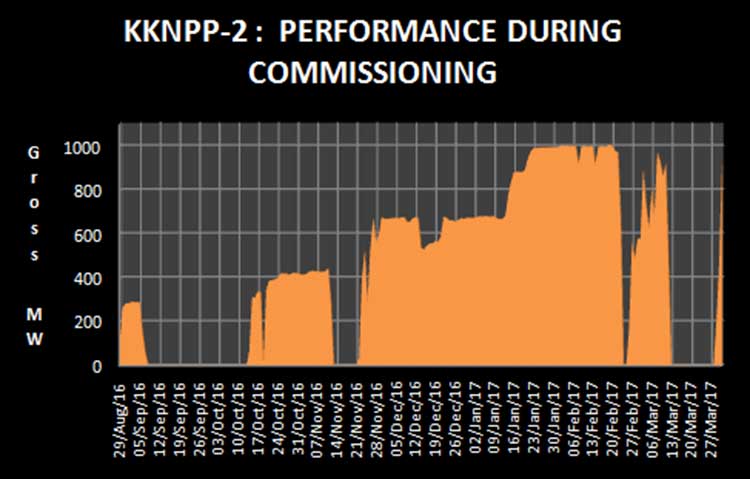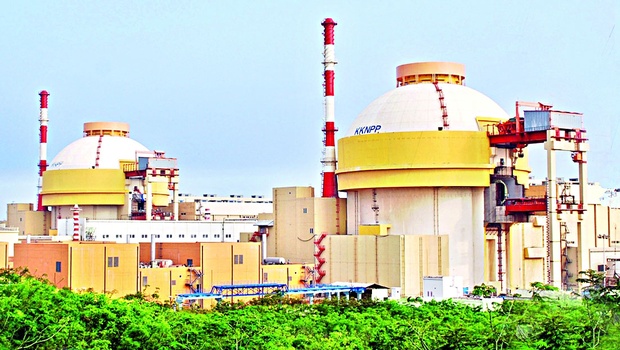
During December 2016, the world’s first Generation-III pressusrized water reactor (PWR)at Kudamkulam Nuclear Power Plant (KKNPP) in India will be shut down for its second refueling. The 1000 MW WWER reactor, a joint venture of Russia’s Rosatom and the Nuclear Power Corporation of India Ltd (NPCIL) was grid connected three years ago. About 56 used (spent) fuel assemblies will be removed from the reactor pressure vessel (RPV) and 56 fresh assemblies will be inserted. Refueling operation is done by a contractor and his men. This is the time when majority of the scientists and reactor personnel avail their well-deserved annual holidays. Refueling is also the time when the people living in the local environment of the plant have to be concerned. As is well known, a nuclear reactor releases radioactive gases like tritium, argon, xenon, carbon14 and iodine, regularly during normal operations, mainly through its 100 meters high stack.
The data of annual releases from each commercial reactor in the world are reported by the United Nations’ Scientific Committee on Atomic Radiation (UNSCEAR) periodically. The environmentalists have been demanding the disaggregated data of daily releases for several decades. Nuclear establishment the world over refused such data for valid reasons. This situation has changed as the German Green Party parliamentarians forced the government to provide the half hourly data of release of radionuclides by the Gundremmingen NPP -in Bavaria, during its refueling operation in September 2011. The chart below shows that the normal emission concentration (of noble gases) during the rest of the year was about 200,000 disintegration per cubic meter of air (Bq/m³). During refueling the emission sharply increased to a peak of 1,470,000 Bq/m³. (The unit shown in the graph is kilo-Bequerel (kBq) which is equivalent to 1000 Bq). From the new data, Nuremberg physicist and statistician, Dr Alfred Körblein estimated that about two thirds of the NPP’s annual emissions occur during the refueling.

Refueling releases a huge radioactive emissions plume The reactor pressure vessel (RPV) in which heat is generated by the fission of uranium atoms is like a pressure cooker. Both the cooker and the RPV release small quantities of gases during ‘cooking’, and massive quantities when the lid of the vessel is opened. Operating nuclear power plants (NPPs) contain large volumes of radioactive gases at high pressures and temperatures. When the reactor is depressurised and opened to refuel once a year, these gases escape creating a spiked emission and a large radioactive plume downwind of the station. Using the German data, Dr Ian Fairlie, an independent consultant and formerly a British civil servant on radiation risks published a paper in the Journal of Environmental Radioactivity, a peer reviewed journal, which was well received by the scientists (500 downloads) and the social media. Fairlie hypothesized that the earlier studies showing higher incidence of childhood cancers in the neighborhood of the nuclear campuses in plausible in the light of the new data. An abstract of Fairlie’s paper is given below.
Dr Ian Fairlie on the radiation risks in nuclear neighborhood
Over 60 epidemiological studies world-wide have examined cancer incidences in children near nuclear power plants (NPPs): most of them indicate leukemia increases. These include the 2008 KiKK study commissioned by the German Government which found relative risks (RR) of 1.6 in total cancers and 2.2 in leukemias among infants living within 5 km of all German NPPs. The KiKK study has retriggered the debate as to the cause(s) of these increased cancers. A suggested hypothesis is that the increased cancers arise from radiation exposures to pregnant women near NPPs. However any theory has to account for the >10,000 fold discrepancy between official dose estimates from NPP emissions and observed increased risks. An explanation may be that doses from spikes in NPP radionuclide emissions are significantly larger than those estimated by official models which are diluted through the use of annual averages. In addition, risks to embryos/fetuses are greater than those to adults and haematopoietic tissues appear more radiosensitive in embryos/fetuses than in newborn babies. The product of possible increased doses and possible increased risks per dose may provide an explanation.
In India, Dr Manjula Datta reported highly significant increase of mental retardation, cancer, infertility etc among the people living within 10 km of the Madras Atomic Power Station at Kalpakkam near Chennai. This study was funded by the Department of Atomic Energy. An earlier study by Dr Pugazhendi and Padmanabhan also showed significant increase of thyroid anomalies among the women in reproductive age in villages within 50 km of the reactor site.
The first refueling in July 2015- Damaged fuel assemblies caused high releases The first refueling of KKNPP-1 reactor was done in July 2015. We had earlier reported about a massive fuel assembly damage in this reactor during January 2014.
Release of radioactivity during the removal of spent fuel will be higher if the fuel rods/assemblies were damaged. Dr SP Udaikumar of the Tamil Nadu Green Party had linked the death of a young contract worker on refueling job to his radiation exposure. While most of the routine releases during normal operation of the reactor happen through the stacks, the releases during the removal of fuel assemblies will be from the reactor building and therefore, exposure of the refueling workers and others on duty in the campus is unavoidable.
During the first ten months of the year 2016, the reactor should have operated on 100% full power for only for 305 days. However, it was on full power for 170 days only. are not in sound health. For the past one month, the reactor has been unstable with its output hovering around 70-80% of the installed capacity. It appears that the fuel assemblies are not in sound health. Save the Children and Fetuses from unnecessary and avoidable exposure Commenting on the German release data, Dr Reinhold Thiel, a member of the German IPPNW Board said: “Especially at risk are unborn children. When reactors are open and releasing gases, pregnant women can incorporate much higher concentrations of radionuclides than at other times, mainly via respiration. Radioactive isotopes inhaled by the mother can reach the unborn child via blood with the result that the embryo/ fetus is contaminated by radioactive isotopes. This contamination could affect blood-forming cells in the bone marrow resulting later in leukemia. This provides a plausible explanation for the findings of the KiKK study published in 2008 that under-fives living near NPPs (in Germany) are considerably more at risk of cancer, particularly leukemia, than children living further away.” The graph above shows that the spike is confined to a narrow window of 36 hours or so. If the neighborhood is informed about the timing of the operation, the vulnerable members like children and pregnant women can stay in-door or go on a holiday to their mothers’ houses. The schools can also be shut down for two days.
The health physics division can be more proactive by placing dosimeters in key locations and decontaminating high dose areas if any. Any dose is an overdose.
VT Padmanabhan is an epidemiologist. He and his team has studied the genetic effects of children of parents exposed to high natural background radiation in Chavara-Neendakara, occupational health hazards and environmental radiation load from the Indian Rare Earths Ltd (IREL), Eloor in Kochi, genetic effects of MIC gases released in the Bhopal accident (1984), reviewed the health studies of Hibakushas of Hiroshima and Nagasaki. He is a member of the European Committee for Radiation Risk (ECRR) and Nuclear Consult Group. E-mail: [email protected]














































